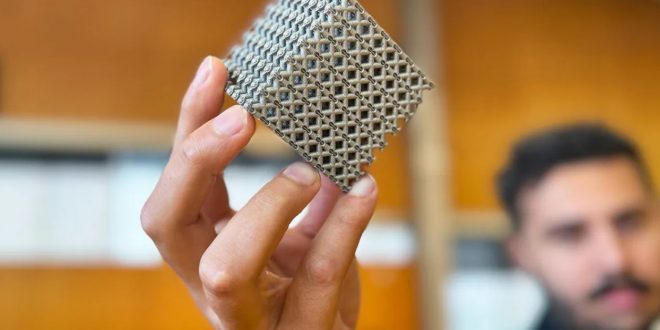RMIT University in Australia has developed a novel 3D printed “metamaterial” that has exceptional strength-to-weight ratios beyond those found in nature and most manufactured materials. This novel material might have substantial consequences for several applications, ranging from medical implants to airplanes to rockets.
The novel metamaterial is created from a conventional titanium alloy and displays electromagnetic characteristics that do not occur naturally. However, do not be deceived, its talent is far from ordinary.
The distinguishing factor is its structure. The material has a distinctive lattice pattern that not only sets it apart but also enhances its strength significantly. The team’s recent investigation found that the material is 50% stronger than the next most robust alloy with a comparable density, often used in aerospace applications.
How was this design conceived? The concept for this novel substance, like many groundbreaking technologies, was derived from observations of the natural world. Strong hallow-stemmed plants like Victoria water lilies and resistant corals such as organ-pipe coral (Tubipora musica) demonstrated how to blend lightness with durability.
However, studying a robust natural framework is distinct from recreating it with synthetic materials. Researchers have long tried to replicate natural hollow “cellular structures” but have faced challenges with production and load stress, resulting in failures.
Distinguished Professor Ma Qian said that stress in complex biological materials should ideally be uniformly distributed. However, in most topologies, less than half of the material typically carries the compressive stress, whereas the majority of the material is structurally unimportant.
The unparalleled new solutions provided by metal 3D printing have been the determining factor in this situation.
We created a hollow tubular lattice construction with an internal thin band. Qian said that the combination of these two elements displays a unique blend of power and lightness that has not been seen in nature previously. By combining two complementing lattice structures efficiently, stress distribution is even, preventing the concentration of stress at weak places.
Efficient strength
Qian and colleagues used laser powder bed fusion to 3D print their design at RMIT’s Advanced Manufacturing Precinct in order to manufacture the novel material. This method fuses layers of metal powder by using intense laser beams.
The result was a titanium lattice cube that is 50% stronger than cast magnesium alloy WE54, the most robust alloy with a comparable density. This innovative design reduced the stress focused on the lattice’s vulnerable areas by 50%.
The construction has a double lattice design that may deflect any fractures that may emerge, preventing them from compromising its toughness.
The construction may be resized accordingly, ranging from a few millimeters to many meters, using various printer models. Additionally, the structure’s printability, biocompatibility, and resilience to corrosion and heat make it a promising innovation for use in several industrial sectors.
Lead author Jordan Noronha said that their titanium metamaterial, which has the same density as the strongest cast magnesium alloy used in high-strength and lightweight applications, was stronger and less likely to change shape permanently when compressed. It was also easier to make.
The team intends to enhance its material and investigate its use in conditions with greater temperatures. The current titanium cube can endure temperatures up to 350°C (662°F), but researchers believe they can enhance its capability to survive temperatures up to 600°C (1,112°F). This material would be ideal for aeronautical engineering and firefighting drones.
Nevertheless, the technology required to produce the new material is not now generally accessible, which might delay its implementation.
“Conventional manufacturing methods are not suitable for creating these complex metal metamaterials, and not everyone has a laser powder bed fusion machine readily available,” Noronha said.
As technology advances, it will become more accessible, and the printing process will grow quicker, allowing a wider audience to use our high-strength multi-topology metamaterials in their components. Metal 3D printing enables the straightforward production of complex shapes for practical use.
 Tech Gadget Central Latest Tech News and Reviews
Tech Gadget Central Latest Tech News and Reviews




